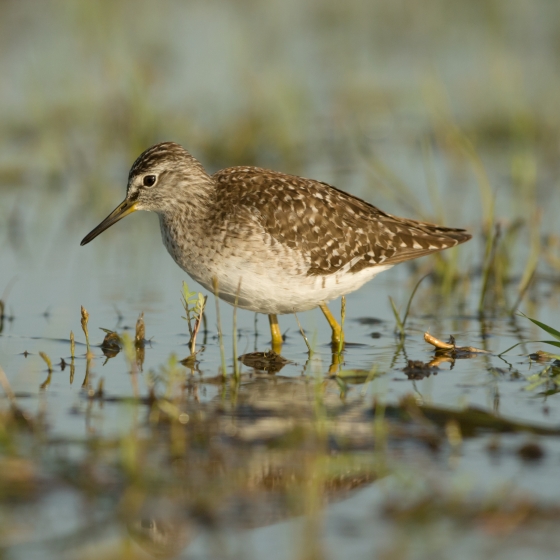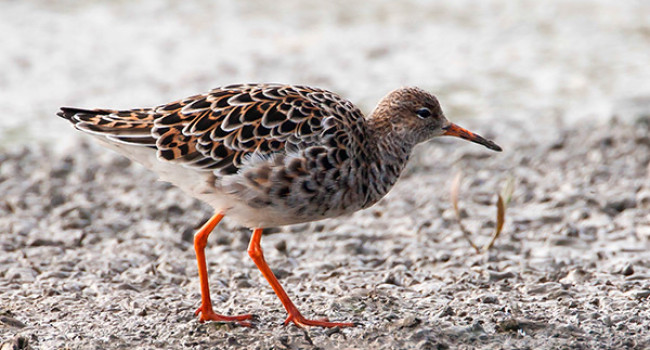Wood Sandpiper
Tringa glareola (Linnaeus, 1758)
OD
 WOOSA
WOOSA  5540
5540

Family: Charadriiformes > Scolopacidae

Wood Sandpiper is a smart wader with elegant proportions. A strong eye stripe and speckled plumage combine to make this a very attractive bird.
Although Britain hosts a small breeding population, confined to the boggy habitats of the very north of Scotland, most birdwatchers are likely to encounter Wood Sandpiper as a passage migrant, mainly in spring.
Migrating Wood Sandpipers break their journey to refuel, preferring small shallow wetlands with plenty of emergent vegetation. Individuals using such sites can be surprisingly difficult to see as they forage amongst the tall plants. In flight, Wood Sandpipers show off dark upperparts and a square white-rump, and they often call with a quickly repeated reedy whistle as they fly away.
Identification
Wood Sandpiper identification is sometimes difficult. The following article may help when identifying Wood Sandpiper.
Identifying Ruff

Ruff, with their variable size and plumage, often present identification issues. However, by learning how to recognise Ruff in their various guises through this video, you’ll be able to pick them out with confidence, and have a great reference point for identifying other similar-looking waders.
- 1 of 2
- next ›
SONGS AND CALLS
Listen to example recordings of the main vocalisations of Wood Sandpiper, provided by xeno-canto contributors.
Call
Song
Develop your bird ID skills with our training courses
Our interactive online courses are a great way to develop your bird identification skills, whether you're new to the hobby or a competent birder looking to hone your abilities.
Browse training coursesStatus and Trends
Population size and trends and patterns of distribution based on BTO surveys and atlases with data collected by BTO volunteers.
CONSERVATION STATUS
This species can be found on the following statutory and conservation listings and schedules.
POPULATION CHANGE
The small population of Wood Sandpiper breeding in Scotland has increased strongly since the 1960s (Chisholm 2007), and particularly over the last 25 years, to a five-year mean of 36 breeding pairs over the period 2015–2019 (Eaton et al. 2021). The European population is believed to be stable and has maintained it's range in recent decades (Keller et al. 2020).
DISTRIBUTION
Wood Sandpipers are very rare breeding waders of boggy habitats in Scotland. Owing to the sensitivity of some of its breeding haunts, breeding distribution is shown here at 50-km resolution. Most breed in Sutherland and Caithness, but also in Inverness-shire, Wester Ross and the Outer Hebrides.
Occupied 10-km squares in UK
| No. occupied in breeding season | 22 |
| % occupied in breeding season | 0.7 |
| No. occupied in winter | 2 |
| % occupied in winter | 0.07 |
European Distribution Map
DISTRIBUTION CHANGE
Range size and population size have both increased slightly since the early 1990s.
Change in occupied 10-km squares in the UK
| % change in range in breeding season (1968–72 to 2008–11) | +22.2% |
| % change in range in winter (1981–84 to 2007–11) | --100% |
SEASONALITY
Wood Sandpiper is a summer visitor and passage migrant in spring and autumn.

Movement
Information about movement and migration based on online bird portals (e.g. BirdTrack), Ringing schemes and tracking studies.
An overview of year-round movements for the whole of Europe can be seen on the EuroBirdPortal viewer.
RINGING RECOVERIES
View a summary of recoveries in the Online Ringing Report.
Foreign locations of birds ringed or recovered in Britain & Ireland

Biology
Lifecycle and body size information about Wood Sandpiper, including statistics on nesting, eggs and lifespan based on BTO ringing and nest recording data.
SURVIVAL & LONGEVITY
View number ringed each year in the Online Ringing Report
Maximum Age from Ringing 
|
7 years 11 months 18 days (set in 1982) 
|
Adult Survival 
|
0.536±0.102  
|
CODES & CLASSIFICATION
Ring size 
|
B+ |
Field Codes 
|
2-letter: OD | 5-letter code: WOOSA | Euring: 5540 |
For information in another language (where available) click on a linked name
Research
Interpretation and scientific publications about Wood Sandpiper from BTO scientists.
CAUSES AND SOLUTIONS
Causes of change
It is not clear why the number of breeding Wood Sandpipers has increased. It has been suggested that the increases in some years could be due to increased numbers of migrants, some of which remain to breed (Chisholm 2007), but this is speculative.
Links to more studies from ConservationEvidence.com
- Use of Willapa Bay, Washington, by shorebirds and waterfowl after Spartina control efforts
- Rush cutting to create nesting patches for lapwings Vanellus vanellus and other waders, Lower Lough Erne RSPB reserve, County Fermanagh, Northern Ireland
- Managed realignment in the UK - the first 5 years of colonization by birds
Read more studies about Wood Sandpiper on Conservation Evidence >
Would you like to search for another species?










Share this page